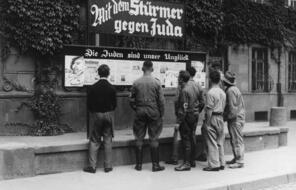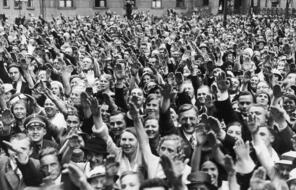Propaganda at the Movies
At a Glance
Language
English — USSubject
- History
- The Holocaust
- Propaganda
Triumph of the Will (Triumph des Willens)
During World War I, the British discovered the power of films to shape public opinion (see reading, Western Front at the Cinema in Chapter 3). The Soviets made a similar discovery in the 1920s. Joseph Goebbels learned from both. He began with the newsreels, short film-based news reports that in those days were played before feature films. In Germany, those newsreels showed the nation as the Nazis wanted it to be seen—rich and powerful in comparison to its neighbors. But propaganda was not limited to newsreels; other kinds of movies made in Nazi Germany also expressed the government’s political and social views.
Some films, like Triumph of the Will by director Leni Riefenstahl, glorified Adolf Hitler and the Nazi Party. The documentary-style film was shot at the 1934 Nazi Party congress and rally in Nuremberg. American Journalist William L. Shirer was new to Germany at the time, and that rally was his first. He describes it this way:
Like a Roman emperor Hitler rode into this medieval town [Nuremberg] at sundown, past solid phalanxes of wildly cheering Germans who packed the narrow streets. . . . Tens of thousands of Swastika flags blot out the Gothic beauties of the place, the facades of the old houses, the gabled roofs. The streets, hardly wider than alleys, are a sea of brown and black uniforms. . . .
About ten o’clock tonight I got caught in a mob of ten thousand hysterics who jammed the moat in front of Hitler’s hotel, shouting: “We want our Führer.” I was a little shocked at the faces, especially those of the women, when Hitler finally appeared on the balcony for a moment. . . . They looked up at him as if he were a Messiah, their faces transformed into something positively inhuman. 1
That was the scene that Leni Riefenstahl captured on film, and her movie became an immediate sensation. It was popular not only in Germany but also in France, where it received an award for “artistry” at the 1937 World Exhibition in Paris.
Other films were not designed to glorify the Nazis but to dehumanize, criminalize, and demonize vulnerable minorities—particularly Jews. Goebbels even issued special instructions on how such movies were to be described. Following these instructions, a brochure that announced the release of the antisemitic film Jud Süss (“Süss, the Jew”) claimed it was “historically accurate” and summarized the plot:
Clean-shaven and dressed like a gentleman, the Jew Süss Oppenheimer contrives to be appointed Finance Minister to the Duke of Wurttemberg . . . Matching one another in treachery, the court Jew and Minister Süss Oppenheimer and his secretary outbid one another in tricks and intrigue to bleed the people of Wurttemberg. . . . The Jew Süss Oppenheimer violates the beautiful Dorothea Sturm, an outrageous act which confirms the extent of his guilt. . . . Jew, hands off German women!
Another antisemitic film, Der ewige Jude (The Eternal Jew), was praised as a documentary but contained such blatant lies that parts of it had to be omitted from the version shown in other countries. Officials feared the hostile tone might damage the film’s “credibility.” Marion Pritchard, then a graduate student in the Netherlands, recalled seeing the film:
We went to see this movie and sat and made smart remarks all the way through and laughed at it because it was so outrageous. And yet when we came out of the movie, one of my Gentile friends said to me, “I wish I hadn’t seen it. I know that it was all ridiculous and propaganda, but for the first time in my life I have a sense of them and us—Jews and Gentiles. I’m going to do everything I can to help them, but I wish I didn’t have this feeling.” 2
Connection Questions
- How did the Nazis use film to create an image of their ideal “national community”? How did they use film to create an image of who would be excluded from this community?
- What did Marion Pritchard’s friend mean when she said, “I know that it was all ridiculous propaganda, but for the first time in my life I have a sense of them and us—Jews and Gentiles”? How do you explain her statement?
- Why does film have the power to engage our emotions? How do television shows or films today help to shape an ideal image of ourselves and our society? Give examples.
- What is a documentary film? How is a documentary film different from a propaganda film? If possible, watch a clip from Triumph of the Will. Based on the description in this reading, or on the clip you viewed, do you think that Triumph of the Will should be considered a documentary film?
- While this reading highlights films with a direct connection to propaganda, the German film industry was very active during the Nazi years, also creating “entertainment” movies like romances and comedies. In what ways might those also have had a role as propaganda? What purpose can entertainment in the media serve for a government?
How to Cite This Reading
Facing History & Ourselves, "Propaganda at the Movies," last updated August 2, 2016.













